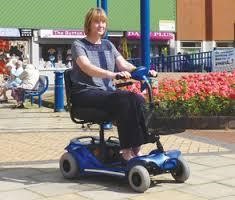
If you’ve just purchased a mobility scooter or are thinking of doing so then safety whilst driving should be a top priority. You will need to learn how to control and handle the scooter to a safe standard and also understand some of the rules of road and pavement. Scooters require a considerable amount of care especially when you consider how much work has gone into making them. Even EHRT Copper Bending Machines are involved.
Like a car, a scooter needs a key for ignition and accelerates in the same way as a car. The speed is controlled by a lever on the handlebars and is mostly operated by the thumb. This lever will control both the forward and reverse motion of the scooter. The handlebars also turn the front column of the scooter which acts as the directional steering column. There are no brakes as such as the scooter will only move on pushing the lever and will stop when this is released. If you have a Class 3 road scooter then training is a great idea and can be offered at disability living services and mobility centres. Before going out, make sure you have fully charged the battery as you don’t want to get stranded with a flat battery.
Getting around can be a liberating and fun experience as long as you are a considerate driver. Whilst travelling on pavements, the pedestrian still has the right of way and you must not travel faster than 4 mph. When in crowded areas, you will probably need to travel slower than this as you will need to weave around people. Turning corners should also be taken at slower speeds to prevent any potential tipping of the scooter.
If you’re planning on using a road scooter then it’s safer to avoid busy roads and the Highway Code still applies. A scooter cannot be driven in bus or cycle lanes or on motorways and dual carriageways that have a speed limit of over 50 mph. If you really must use a dual carriageway then legally you have to display a flashing amber light. You don’t need to tax a road scooter but you will need to register it with the DVLA. Insurance is optional but also recommended.
When approaching a kerb it is best to come at it straight on but it’s far easier to stick to routes where you can guarantee there will be dropped kerbs. When on the pavement it is your responsibility to ensure you don’t hit anyone or do any damage with your vehicle. Whilst many shops, attractions, restaurants and public areas are very accessible these days and will have many features specifically designed for those with limited mobility, you could still face difficulties whilst navigating town centres. There might not always be a lift that is conveniently placed, particularly in older buildings. Some floors have a few steps up to different level and of course, this will remain inaccessible to you on a scooter. When using a lift, unless its doors open on both sides, remember that you will need to reverse out into the shop. Therefore, it is imperative that you feel totally confident in maneuvering in a safe manner.





